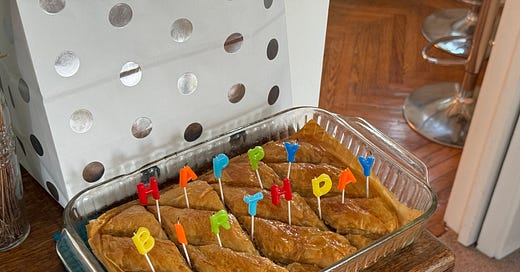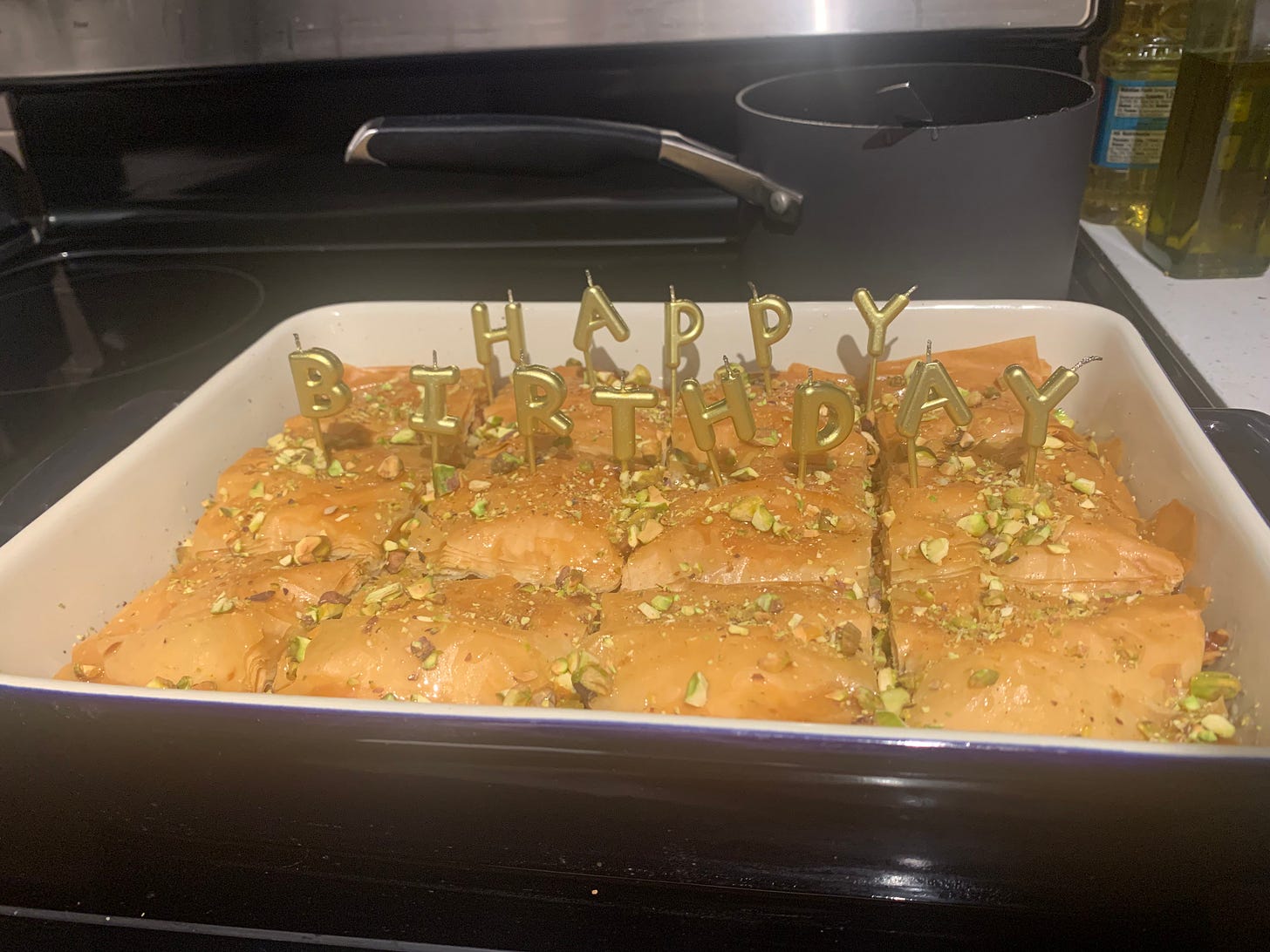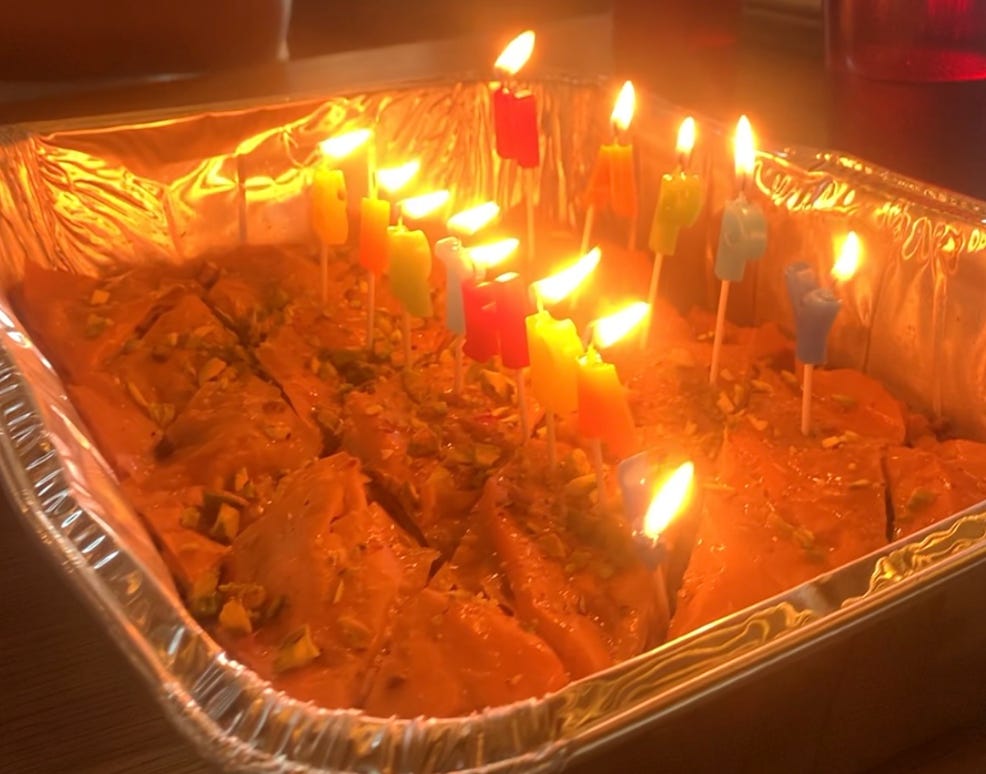The first dessert I ever baked from scratch was for my crush. It was July and and his birthday approached in August. As the summer began to wane in blonde hues, I let it soak my skin. Only this warmth fell second to the distinct will-they-won’t-they tension that had grown dense in the hot Texas air between us. One of those hot days, we sat on a bench during an evening walk and I couldn’t help but release — in a spontaneous effort to cool this air — my feelings for him.
“Do with that information what you will,” I said, finally, cooly. My charged words resounded in my head, then coupled with the thought, Did I really just do that??
In the days that followed, we indulged in bigger, goofier grins, the kind where your nose scrunches and your eyelids curl and your joy can’t help but spill out of you like spaghetti off a spoon. I knew that as those golden moments grew, words alone wouldn’t be enough. Actions — then, now, and always — speak the loudest.
Prior to launching my emotions into the air like a toddler with a new and strange snack, I had asked him what his favorite dessert was on one of the many Wednesdays we worked from a coffee shop. We had paused from scrolling our inboxes to eat lunch. To be honest, though his birthday was less than a month away, I had no ulterior motive by asking this question, I simply wanted to know more about him. I naturally began to take another bite while I waited for his answer. He simply didn’t believe my head wasn’t teeming with how to surprise him for his birthday. He simply didn’t believe I could be that into my kale caesar salad. (I was).
Despite this suspicion, he thoughtfully paused at my question before responding: “Baklava.”
My eyebrows raising in surprise crystallized how wrong my expectation of his answer was. At this point in our relationship, all I knew was that he loved cookie dough ice cream. Following this — I now realize one-dimensional — line of thinking, I was ready to receive strong feelings about a chocolate chip cookie or a sundae or even a distinct fondness for a brownie, perhaps. I was not expecting a honey-laden pastry to be the prized frontrunner. (And yet, that’s one of the best things I’ve learned: Let people surprise you.)
I searched, and the only reason I found for baklava’s relative absence in my mind was because I didn’t grow up eating it. My bias perhaps stems from my mom, who baked cookies or brownies or cake or pie at the turn of a dime during my childhood, moments both arbitrary and delightful. She was a mom who would also freeze rolls of cookie dough so that a warm treat was always just 15 minutes away (of the many habits I have and will adopt from her, this is one that I most covet). Those flavors felt comfortable, familiar, even nostalgic to me. Hell, I loved cookie dough ice cream too.
As I searched for any connection I held to baklava in my mind, a memory abruptly surfaced of a Greek restaurant from my childhood. It’s where, on Tuesday nights, my family would sit in a booth and eat dinner waiting for me to finish my hip hop or jazz class at the dance studio next door. Over 10 years later, that restaurant is now a New York-style pizzeria and the dance studio stands vacant. But I still remember the smell of honey and feta that betokened an active Greek kitchen. Except, after every class, I would run into the restaurant and devour instead of crackling phyllo, spoon after spoon of cinnamon-dusted rice pudding. And if their baklava was as good as their rice pudding was, I’m disappointed I never strayed.
As I sifted through this memory, the shapes and smells that permeated it, I understood that a chapter was beginning — one that would change the way I’d think about baklava.
The birth of birthday baklava
Before knowing how to make it, I was hesitant about executing a dessert I had only eaten a handful of times. The same nerves that had fearlessly laid bare my feelings were still present, yet its spirit of abandon had suddenly ducked out. As I read a recipe our mutual friend sent me, I began to hype myself up, coaxing this spirit until it came once again roaring to the surface.
“What’s the worst that could happen?” I suddenly heard myself say. This 9x13 inch dessert seemed like an outcome I could achieve — and this was paramount, because it was something I wanted to be meaningful. This flaky pastry would demonstrate my commitment not only to the mass of phyllo dough that would be left in my freezer, but to a future between us together. A heartfelt gesture that said: I mean what I say. I’m excited to celebrate your years. I’m ready to create something beautiful from scratch.
I was led down a rabbit hole deciding which nut to spread in my baklava after only being left with the recipe’s vague “1 pound chopped nuts.” The more I read, the more I learned how large the category of baklava is. There were innumerable iterations, adapted in different parts of the world to local ingredients, taste, and traditions. I saw variations of every element — the nut, the dough, the syrup, the shape, the cut — and with respect to the nut choice specifically, I found versions with a sole nut or a combination of pistachios, walnuts, almonds, or pecans. I even learned about variants with cashews and pine nuts. Everyone who made baklava did it a little differently.
I ultimately decided on a pistachio and walnut mixture, as it was a combination most similar to what I have tasted in the past and one I was certain my crush would enjoy. I decided to buy phyllo dough from the grocery store (and in the process, gained a deference to the masterful hand of those who make phyllo, an activity I was not so naive to attempt in my first baklava bake), but there posed a problem: I couldn’t find any. I pondered if it was considered a specialty ingredient in Austin, given its scarcity in grocery stores, or simply if everyone in the city had also decided at that very moment to make baklava and beat me to the freezer section. I drove breathlessly to a fourth grocery store and finally spotted a pack at the bottom of a freezer, half hidden by the pre-made pie crusts. An odd and appetizing sense of justice washed over me. Success in this pursuit made me more committed to my task than ever.
The same friend offered to come over and help bake the baklava. He chopped the nuts while I quickly assembled layer after layer of phyllo dough, gilding each with melted butter. We chatted while we constructed, the conversation abruptly ceasing only when I urged my sous-chef to chop faster. I was unsure how long the wet paper towel covering the wispy sheets of dough would keep them moist. The last thing my anxiety could handle was the dough to rip and turn this love-soaked offering into a haphazard pile of dough and nuts and sugar. Yes, my frantic energy from the phyllo hunt had carried over to the kitchen. Is it obvious? It ain’t over ‘till it’s over.
But what came out of the oven 45 minutes later was a beautiful pan of a neat, flaky bronzed dessert. I spooned the hot syrup of water, sugar, honey, and vanilla over the pan of plump pastry and a hissing crackle sang from it. Baklava may be the most visceral dessert I’ve ever made. Our eyes and mouths grew wide; our own efforts impressed us.
My touch gingered with focus, I sprinkled chopped pistachios on top and inserted gold-lettered candles that spelled out H-A-P-P-Y B-I-R-T-H-D-A-Y. My crush knocked on my apartment door and I let him in to the scene in my kitchen. We waited for him to notice our honeyed gift on the counter in front of him. As I moved down to light the candles, at last he saw it and his mouth fell open in a large smile. Each candle aflame, we sang.
Beginnings and endings
The earliest versions of modern baklava are estimated to date back to the Ottoman Empire in the fifteenth century. Over time, the roots of this dessert have grown deep within different cultures of the Mediterranean, Middle East, and North Africa. Historically, baklava was coupled with special occasions, such as banquets, engagements, and weddings, or religious holidays, such as Christmas, Ramadan, Rosh Hashanah. Given the fact that it has long accompanied celebrations, a birthday, it occurred to me, felt like a very appropriate occasion for this dish. The tradition we sought to create was very much in the common spirit of its beginnings.
I became fascinated by the iterations of baklava, each boasting distinct regional flavor profiles in the type of nut, syrup ingredients, assembly shape, and even the type and texture of the dough. I read that in a popular Iranian baklava from Yadz, rosewater is added to the homemade dough and the syrup. The famed pistachio-producing city of Gaziantep, Turkey liberally adorns its pastry with the nut, young and green. Ballourieh, a type of baklava hailing from Syria, has nuts nestled in the middle of shredded phyllo dough called kataifi and is served nearly raw. These are only a few of the ways baklava differs across countries, not including the way recipes also vary within smaller communities and families within those communities.
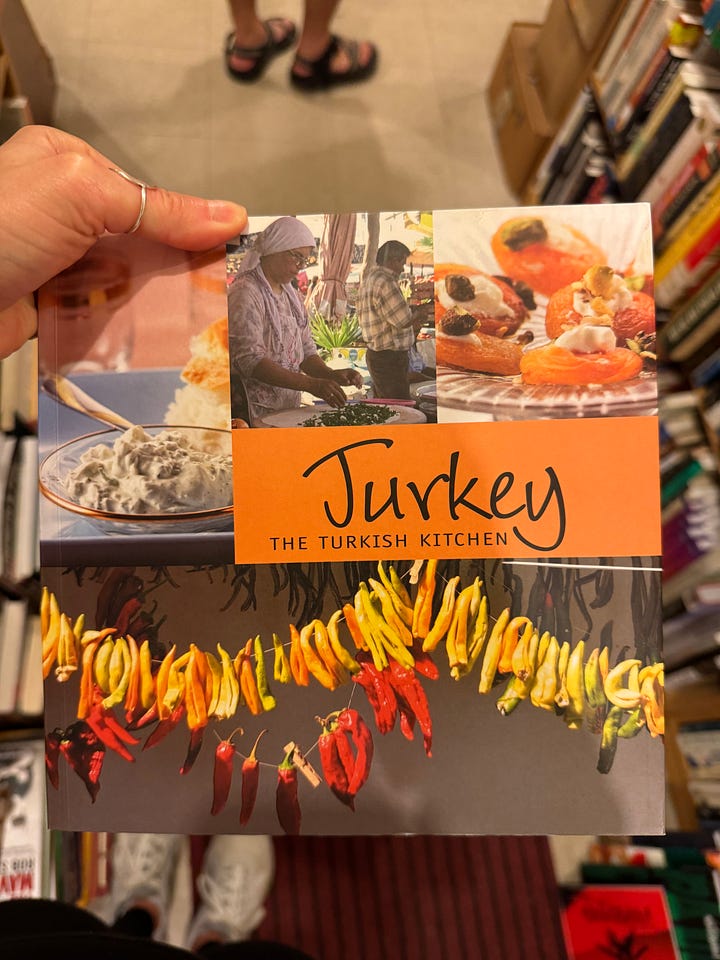
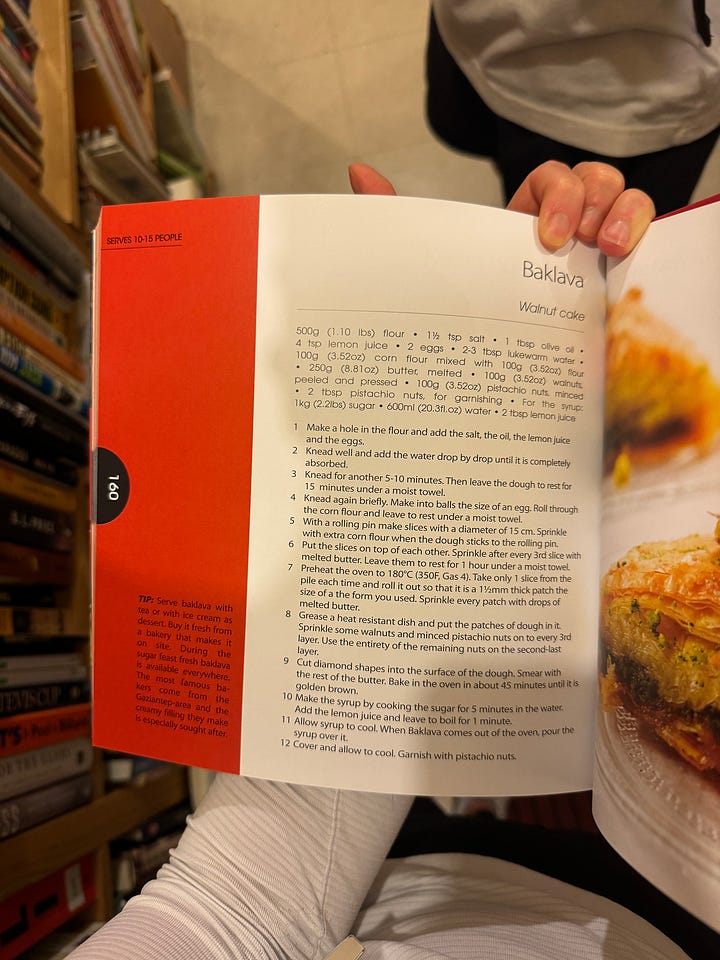
What I’ve learned from digesting all this information and making baklava myself, at this point from a few different recipes, is that it's a dish that rewards those who have patience with patterns. The “easy” recipe I baked from that first time didn’t feel — as it promised — complex but relied on an even hand and fine attention to each element. This sentiment, which served as a through-line in every recipe I came across, is also arguably the most vital in any baked good.
In practice, this precision looks like caressing the dough with butter in even and gentle strokes. Fairly distributing the nuts and feeling their weight in the soft part of my palm, as the knife slices through each unbaked layer. Gently spooning the syrup over the baked pastry and inhaling hot cinnamon and honey. The next best part of this process is the following day when all the elements irrevocably coalesce, thanks in part to such careful crafting. Then, even the smallest slice satiates us, and we relish the sweet, generous glaze it leaves in our mouths.
It struck me how making baklava is a time that cooking made me feel distinctly like an artist — the movement of my buttered pastry brush were both liberal and measured, and the phyllo slid across the pads of my fingers as tenderly as papier mâché on the hands of a sculptor. The better acquainted I am with my tools as a cook, phyllo in this case, the more confident I feel in creating something that is a faithful reflection of my deepest instincts, artistic and otherwise.
Golden, inside and out
That crush is now my boyfriend, and I bake his birthday baklava every year — this year was the third annual. I am now familiar with handling the ghostly fineness of phyllo, the preferred ratio of pistachio to walnut, and am in the final stages of mastering my diagonal cut. Among the published recipes I read through in my research, this year I decided to make Eric King’s for Pistachio-Walnut Baklava. He shared in his newsletter that it was his mother’s, whose family on her father’s side is from Lebanon. The recipe contained a particular method I wanted to try, and I am happy to say, it tastes as splendid as it looks. (I also highly recommend watching Eric make it with Dan Pelosi, arguably as sweet and satisfying as the dessert itself).
As my crush (yes, still) and I licked the sticky syrup off our own fingers this year, I felt what birthday baklava had come to represent was so much more than a dish marking a celebration — if our relationship were a dessert, it would be baklava.
My initial feelings still imbue me, like honey syrup in cut crevices, when I think of what the pair of us have built from scratch. The confection was borne into being, piping hot from the oven, from an initial desire to show my care for someone. It’s this genuine intention that I love so much about cooking. I didn’t simply will it into existence, I worked to produce it every year with my own two hands: fingers chalky chunks from sprinkling nuts, liquified butter splattering the countertop, and a slight quiver in my core as I anxiously handled sheets of phyllo. Layer by layer, with patience and attention, all elements in our creation shine, and when sliced in servings, affirm a reliable balance of flavor and fun. Every year, I bake this dessert with the same care I did in that first year, and it’s taught me that every moment in our relationship is an opportunity to do the same. I don’t always have help or a table of friends to share it with, but the treat shines every time, as if freshly kissed with birthday morning dew.
I am now unabashed in my motion to relieve birthday cake or cookies or brownies of their duty this time of year. In our house, we have made this delicious, culturally and buttery-rich dessert a birthday tradition. Plus, it’s a uniquely joyful feeling to insert birthday candles into anything you please (in fact, I recommend it).
As I slid the casserole of ingredients into the oven to bake, what baked with it were all my hopes for our future together, hopes that continued to develop under direct heat to form a consentient crumb. What emerged was a flaky dessert to convey my undeniably unflaky feelings, just as golden as that summer.


